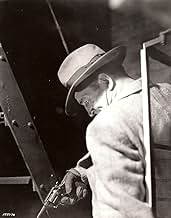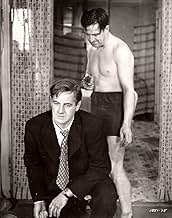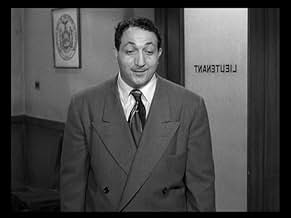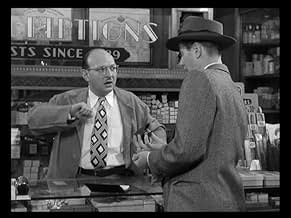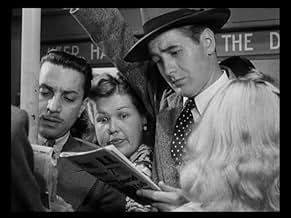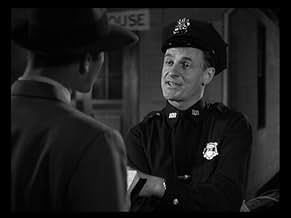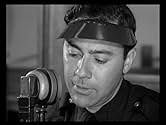IMDb RATING
7.5/10
17K
YOUR RATING
A step-by-step look at a murder investigation on the streets of New York.A step-by-step look at a murder investigation on the streets of New York.A step-by-step look at a murder investigation on the streets of New York.
- Won 2 Oscars
- 6 wins & 5 nominations total
Ted de Corsia
- Willy Garzah
- (as Ted De Corsia)
Mark Hellinger
- Narrator
- (voice)
Jean Adair
- Little Old Lady
- (uncredited)
Celia Adler
- Dress Shop Proprietress
- (uncredited)
Janie Alexander
- Girl
- (uncredited)
Joyce Allen
- Shopgirl
- (uncredited)
Beverly Bayne
- Mrs. Stoneman
- (uncredited)
Featured reviews
There are two styles of Film Noir. Fueled by writers like James M. Cain, Dashiell Hammett, and Raymond Chandler, the first style emerged in the 1940s and was characterized by a cynical, often witty tone; anti-heroes, dangerous women, and assorted criminal elements; and complex plots that emphasized betrayal and moral ambiguity. It was also photographed in a remarkable visual style that combined glossy production values with atmospheric emphasis on light and shadow--and films like THE MALTESE FALCON, THIS GUN FOR HIRE, MILDRED PIERCE, THE BLUE DAHLIA, and DOUBLE INDEMNITY remain great classics of their kind.
But after World War II public taste began to change. Things that could only be hinted at in earlier films could now be more directly stated, and as audiences clamored for a more gritty realism the glossy sophistication of 1940s Noir fell out of fashion. The result was a new style of Noir--photographed in a grainier way, more direct, more brutal, and even less sympathetic to its characters. And the 1948 THE NAKED CITY was among the first to turn the tide. The sophisticated gumshoe, slinky gun moll, and glossy production values were gone; this film felt more like something you might read in a particularly lurid "true detective" tabloid.
In an era when most films were shot on Hollywood backlots, THE NAKED CITY was actually filmed in New York--and while filmmakers could film with hidden cameras sound technology of the day posed a problem. But producer Mark Hellinger turned the problem into an asset: the film would be narrated, adding to the documentary-like style of the cinematography and story. (Hellinger performed the narrative himself, and his sharp delivery is extremely effective.) The story itself reads very much like a police report, following NYPD detectives as they seek to solve a dress model's murder.
For 1948 it was innovative stuff-but like many innovative films it falters a bit in comparison to later films that improved upon the idea. The direct nature of the plot feels slightly too direct, slightly too simple. The same is true of the performances, which have a slightly flat feel, and although Barry Fitzgerald gives a sterling performance he is very much a Hollywood actor whose style seems slightly out of step alongside the deadpan style of the overall cast. Even so, the pace and drive of the film have tremendous interest, and while you might find yourself criticizing certain aspects you'll still be locked into the movie right to the very end. Particularly recommended for Film Noir addicts, who will be fascinated to see the turning point in the style.
Gary F. Taylor, aka GFT, Amazon Reviewer
But after World War II public taste began to change. Things that could only be hinted at in earlier films could now be more directly stated, and as audiences clamored for a more gritty realism the glossy sophistication of 1940s Noir fell out of fashion. The result was a new style of Noir--photographed in a grainier way, more direct, more brutal, and even less sympathetic to its characters. And the 1948 THE NAKED CITY was among the first to turn the tide. The sophisticated gumshoe, slinky gun moll, and glossy production values were gone; this film felt more like something you might read in a particularly lurid "true detective" tabloid.
In an era when most films were shot on Hollywood backlots, THE NAKED CITY was actually filmed in New York--and while filmmakers could film with hidden cameras sound technology of the day posed a problem. But producer Mark Hellinger turned the problem into an asset: the film would be narrated, adding to the documentary-like style of the cinematography and story. (Hellinger performed the narrative himself, and his sharp delivery is extremely effective.) The story itself reads very much like a police report, following NYPD detectives as they seek to solve a dress model's murder.
For 1948 it was innovative stuff-but like many innovative films it falters a bit in comparison to later films that improved upon the idea. The direct nature of the plot feels slightly too direct, slightly too simple. The same is true of the performances, which have a slightly flat feel, and although Barry Fitzgerald gives a sterling performance he is very much a Hollywood actor whose style seems slightly out of step alongside the deadpan style of the overall cast. Even so, the pace and drive of the film have tremendous interest, and while you might find yourself criticizing certain aspects you'll still be locked into the movie right to the very end. Particularly recommended for Film Noir addicts, who will be fascinated to see the turning point in the style.
Gary F. Taylor, aka GFT, Amazon Reviewer
This is a great Film Noir movie which I enjoyed very much. My favorite part is watching all the 100's of people on the streets on New York City not having a clue that the are immortalized in this motion picture. I love to freeze frame the street scenes and view how life was like in 1948. So many surprises, for example in the phone booth scene, notice the two men peering out the window in the store across the street. I think those guys were aware of the filming, but as the scene continued, they went back to serving their customers. Just plain magic. There is also a cool goof in this film. Note during the train station chase scene, just after Frank runs by, the director or a film crew member turns towards the camera and yells what I believe is "CUT"...So Fun....I'll see again and again and again!
Can film noir work in broad daylight - surely a contradiction in terms..? Well, here, it's attempted and largely pulled off by director Jules Dassin with a down-to-earth almost documentary realism which fully involves the viewer in the action as the well-known tag-line "1 of 8,000,000 stories" (the murder of a pretty female immigrant who's fallen into bad company and criminal habits) is played out over a three-day period in a sunny summery New York cityscape. William Daniels' excellent photography captures a city constantly on the move with its own citizens as accidental extras and actual locations as would-be film-sets. Just as effective is the natural vernacular dialogue with some great one-liners thrown in - none better than Barry Fitzgerald seemingly admiring the rear view of a retreating beautiful female suspect with the remark to a junior colleague "Beautiful long legs she has, wouldn't you say?" to which the underling readily concurs only for old pro Fitzgerald to snap "Keep them in sight for the next 48 hours!" detailing a tail on her. There's also another great scene where the murdered girl's mother berates to all and sundry her dead daughter for her reckless lifestyle and bringing of shame onto her family right up until she is taken to identify the corpse where she breaks down uncontrollably, her maternal feelings restored. The murder tale is slightly convoluted but reasonably easy to follow, no contrived clever-clever plotting here, just an everyday relatively uncomplicated murder, solved by routine police work which makes the headlines due to the beauty of the victim. There's close attention paid to forensics and even the insertion of scenes where perennial sad hoaxers come forward to either claim to solve the murder or even confess to it. The acting is mostly good, Fitzgerald is dapper and spot-on as the world-weary 'tec and his supporting officers all acquit themselves well too. The playing however of some of the criminals gets a little overwrought at times and jars the mood slightly. The film arrives at a reasonably exciting conclusion high above Williamsburg Bridge before the city goes back to sleep awaiting its next story... All done and dusted in 90 very watchable minutes, this is a very entertaining film-blanc I suppose you'd have to call it.
That's just what the producer, Mark Hellinger does. He tries to make it clear from the introduction that this is not your average movie. It is not. This entire production tries to accomplish one thing - authenticity. And for the most part, it succeeds.
Before I get to what's right about this movie, let me mention a few of the things that are wrong. Ted DeCorsia overacts. He always overacts. Howard Duff's character, Frankie Niles, is supposed to be a streetwise grifter. How the hell could he be dumb enough to get himself in as many pickles as he did. Anybody who has ever been around the block would know better than to lie to the cops about everything. Just lie about the important things and tell the truth when it won't hurt you. If this guy is a sociopath, he's the dumbest one in town. Although most of the accents are on the money, the incidental dialogue injected into some of the scenes sounds forced and phony. In fact, it sounds like Hollywood trying to sound like New York. Mark Hellinger's narration, by comparison, is not only authentic, it's practically Damon Runyonesque.
Now - what's right. Practically everything else. The location photography is the New York I remember as a kid. While I was watching some of the hot summer scenes downtown, I could practically smell the asphalt, melting tar, and garbage. Don Taylor's brick duplex in Queens was just the kind of house that every struggling family on the wrong side of Brooklyn aspired to.
I won't comment on the story except to say, it's an entirely believable crime story. I seem to remember Barry Fitzgerald playing a similar role in Union Station. Reminds one of the old days when most of the cops were Irish - and New York was really New York.
Before I get to what's right about this movie, let me mention a few of the things that are wrong. Ted DeCorsia overacts. He always overacts. Howard Duff's character, Frankie Niles, is supposed to be a streetwise grifter. How the hell could he be dumb enough to get himself in as many pickles as he did. Anybody who has ever been around the block would know better than to lie to the cops about everything. Just lie about the important things and tell the truth when it won't hurt you. If this guy is a sociopath, he's the dumbest one in town. Although most of the accents are on the money, the incidental dialogue injected into some of the scenes sounds forced and phony. In fact, it sounds like Hollywood trying to sound like New York. Mark Hellinger's narration, by comparison, is not only authentic, it's practically Damon Runyonesque.
Now - what's right. Practically everything else. The location photography is the New York I remember as a kid. While I was watching some of the hot summer scenes downtown, I could practically smell the asphalt, melting tar, and garbage. Don Taylor's brick duplex in Queens was just the kind of house that every struggling family on the wrong side of Brooklyn aspired to.
I won't comment on the story except to say, it's an entirely believable crime story. I seem to remember Barry Fitzgerald playing a similar role in Union Station. Reminds one of the old days when most of the cops were Irish - and New York was really New York.
THE NAKED CITY is like watching a time capsule unfold of New York City in the late '40s--the cars, the subways, the bridges, the people bustling along busy streets totally unaware of filming (scenes were shot from cars with tinted windows and two-way mirrors), and at the center of it all is a rather routine detective story. But the difference is the style that director Jules Dassin gets out of his material, giving the drama a chance to build up the proper tension before the final shootout on city streets and bridges.
BARRY FITZGERALD is the detective with the very helpful sidekick DON TAYLOR, a young police officer from Queens who helps him track down the man responsible for the death of a pretty blonde in what the tabloids called "The Bathtub Murder". Both men are excellent as they follow a batch of clues to get to the bottom of the crime. HOWARD DUFF is also excellent as a man mixed up in the robberies, with DOROTHY HART as his unsuspecting sweetheart.
TED DeCORSIA, making his film debut, is the athletic villain, working out in his small apartment when detective Taylor finds him--but soon making his escape which leads to the film's most breathtaking moments of a dazzling chase that fills the last ten minutes with high tension suspense.
The crime itself is not that interesting, but the style used to tell the tale (with a voice-over narration telling us at the conclusion that this is just one story in a city of millions) is what makes it far superior to most detective stories. That and the fact that New York City is given the spotlight for location photography that really hits the mark.
BARRY FITZGERALD is the detective with the very helpful sidekick DON TAYLOR, a young police officer from Queens who helps him track down the man responsible for the death of a pretty blonde in what the tabloids called "The Bathtub Murder". Both men are excellent as they follow a batch of clues to get to the bottom of the crime. HOWARD DUFF is also excellent as a man mixed up in the robberies, with DOROTHY HART as his unsuspecting sweetheart.
TED DeCORSIA, making his film debut, is the athletic villain, working out in his small apartment when detective Taylor finds him--but soon making his escape which leads to the film's most breathtaking moments of a dazzling chase that fills the last ten minutes with high tension suspense.
The crime itself is not that interesting, but the style used to tell the tale (with a voice-over narration telling us at the conclusion that this is just one story in a city of millions) is what makes it far superior to most detective stories. That and the fact that New York City is given the spotlight for location photography that really hits the mark.
Did you know
- TriviaMost of the street scenes were shot on location in New York without the public's knowledge. Photographer William H. Daniels and his uncredited assistant Roy Tripp filmed people on the streets using a hidden camera from the back of an old moving van. Occasionally, a fake newsstand with a hidden camera inside was also set up on the sidewalk to secretly film the actors. Director Jules Dassin hired a juggler to distract the crowds and also hired a man to occasionally climb up on a light post and give a patriotic speech, while waving an American flag to get the crowd's attention.
- GoofsDuring the end pursuit, Garzah walks past a plump, dark-haired lady in a floral dress, pushing a baby in a stroller. As Donahue pursues in a following scene, he passes the same woman, now walking without her baby carriage and her left hand bandaged.
- Crazy creditsThe opening credits are spoken by producer/narrator Mark Hellinger. No credits are seen on the screen.
- ConnectionsFeatured in The Movie Orgy (1968)
- SoundtracksSobre las Olas (Over the Waves)
(1887) (uncredited)
Written by Juventino Rosas
Background music for the girls on swings
- How long is The Naked City?Powered by Alexa
Details
Box office
- Gross US & Canada
- $2,400,000
- Runtime
- 1h 36m(96 min)
- Color
- Aspect ratio
- 1.37 : 1
Contribute to this page
Suggest an edit or add missing content


